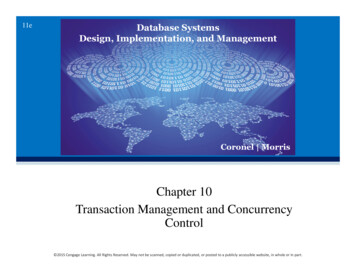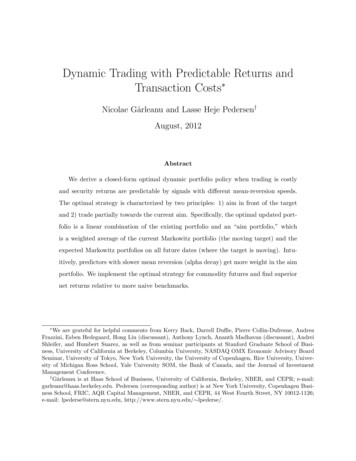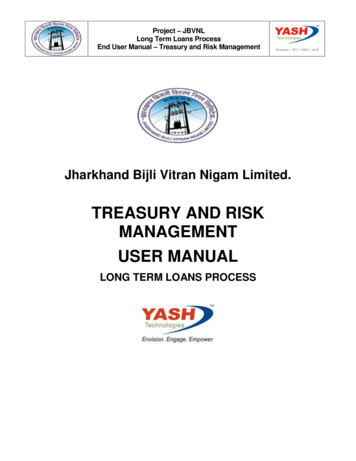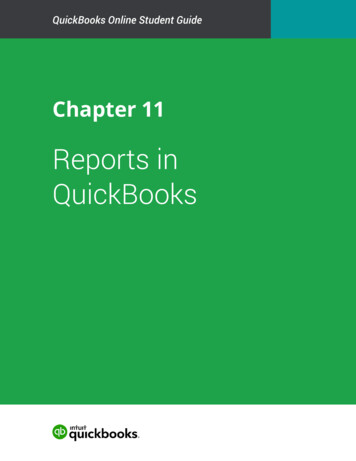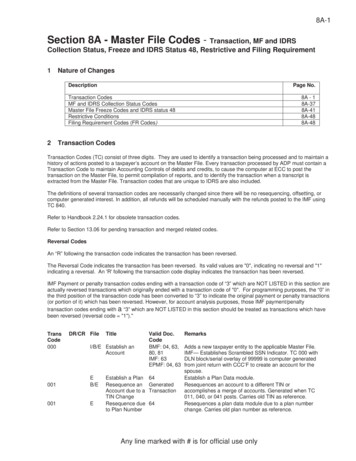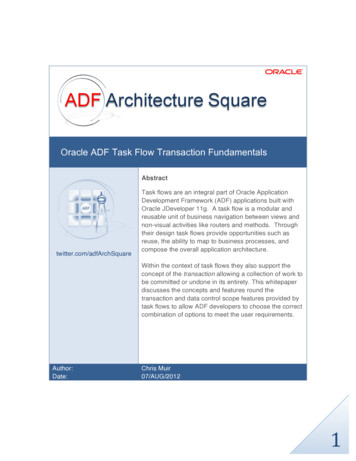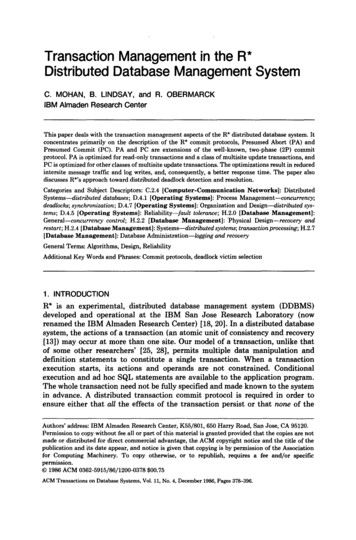
Transcription
Transaction Management in the R*Distributed Database Management SystemC. MOHAN, B. LINDSAY, and R. OBERMARCKIBM Almaden Research CenterThis paper deals with the transaction management aspects of the R* distributed database system. Itconcentrates primarily on the description of the R* commit protocols, Presumed Abort (PA) andPresumed Commit (PC). PA and PC are extensions of the well-known,two-phase (2P) commitprotocol. PA is optimized for read-only transactions and a class of multisite update transactions, andPC is optimized for other classes of multisite update transactions. The optimizations result in reducedintersite message traffic and log writes, and, consequently, a better response time. The paper alsodiscusses R*‘s approach toward distributed deadlock detection and resolution.Categories and Subject Descriptors: C.2.4 s-distributeddatahes;D.4.1 [OperatingSystems]: Process Management-concurrency;deadlocks, syndvonization;D.4.7 [OperatingSystems]: Organization and Design-distributedsystems; D.4.5 [OperatingSystems]: Reliability--faulttolerance; H.2.0 [DatabaseManagement]:General-concurrencycontrol; H.2.2 [DatabaseManagement]:‘Physical Design-recoueryandrestart; H.2.4 [Database Management]:Systems-ditributedsystems; transactionprocessing;H.2.7[Database Management]:Database Administration-loggingand recoueryGeneral Terms: Algorithms,AdditionalDesign, ReliabilityKey Words and Phrases: Commit protocols,deadlock victim selection1. INTRODUCTIONR* is an experimental, distributed database management system (DDBMS)developed and operational at the IBM San Jose Research Laboratory (nowrenamed the IBM Almaden Research Center) 118, 201. In a distributed databasesystem, the actions of a transaction (an atomic unit of consistency and recovery[13]) may occur at more than one site. Our model of a transaction, unlike thatof some other researchers’ [25, 281, permits multiple data manipulation anddefinition statements to constitute a single transaction. When a transactionexecution starts, its actions and operands are not constrained. Conditionalexecution and ad hoc SQL statements are available to the application program.The whole transaction need not be fully specified and made known to the systemin advance. A distributed transaction commit protocol is required in order toensure either that all the effects of the transaction persist or that none of theAuthors’ address: IBM Almaden Research Center, K55/801,650 Harry Road, San Jose, CA 95120.Permission to copy without fee all or part of this material is granted provided that the copies are notmade or distributed for direct commercial advantage, the ACM copyright notice and the title of thepublication and its date appear, and notice is given that copying is by permission of the Associationfor Computing Machinery.To copy otherwise, or to republish, requires a fee and/or specificpermission.0 1986 ACM 0362-5915/86/1200-0378 00.75ACM Transactionson Database Systems, Vol. 11, No. 4, December1966, Pages 373-396.
Transaction Management in the R’ Distributed Database Management System’379effects persist, despite intermittent site or communication link failures. In otherwords, a commit protocol is needed to guarantee the uniform commitment ofdistributed transaction executions.Guaranteeing uniformity requires that certain facilities exist in the distributeddatabase system. We assume that each process of a transaction is able toprovisionally perform the actions of the transaction in such a way that they canbe undone if the transaction is or needs to be aborted. Also, each database of thedistributed database system has a log that is used to recoverably record the statechanges of the transaction during the execution of the commit protocol and thetransaction’s changes to the database (the UNDO/REDO log 114, 151). Thelog records are carefully written sequentially in a file that is kept in atoMe(nonvolatile) storage [17].When a log record is written, the write can be done synchronously or asynchronously. In the former case, called forcing a log record, the forced log recordand all preceding ones are immediately moved from the virtual memory buffersto stable storage. The transaction writing the log record is not allowed to continueexecution until this operation is completed. This means that, if the site crashes(assuming that a crash results in the loss of the contents of the virtual memory)after the force-write has completed, then the forced record and the ones precedingit will have survived the crash and will be available, from the stable storage,when the site recovers. It is important to be able to “batch” force-writes for highperformance [ 111. R* does rudimentary batching of force-writes.On the other hand, in the asynchronous case, the record gets written to virtualmemory buffer storage and is allowed to migrate to the stable storage later on(due to a subsequent force or when a log page buffer fills up). The transactionwriting the record is allowed to continue execution before the migration takesplace. This means that, if the site crashes after the log write, then the recordmay not be available for reading when the site recovers. An important point tonote is that a synchronous write increases the response time of the transactioncompared to an asynchronous write. Hereafter, we refer to the latter as simply awrite and the former as a force-write.Several commit protocols have been proposed in the literature, and some havebeen implemented [8, 16, 17, 19, 23, 26, 271. These are variations of what hascome to be known as the two-phase (2P) commit protocol. These protocols differin the number of messagessent, the time for completion of the commit processing,the level of parallelism permitted during the commit processing, the number ofstate transitions that the protocols go through, the time required for recoveryonce a site becomes operational after a failure, the number of log records written,and the number of those log records that are force-written to stable storage. Ingeneral, these numbers are expressed as a function of the number of sites orprocesses involved in the execution of the distributed transaction.Some of the desirable characteristics in a commit protocol are (1) guaranteedtransaction atomicity always, (2) ability to “forget” outcome of commit processingafter a short amount of time, (3) minimal overhead in terms of log writes andmessagetraffic, (4) optimized performance in the no-failure case, (5) exploitationof completely or partially read-only transactions, and (6) maximizing the abilityto perform unilateral aborts.ACM Transactions on Database Systems, Vol. 11, No. 4, December 1986.
380lC. Mohan et al.This paper concentrates on the performance aspects of commit protocols,especially the logging and communication performance during no-failure situations. We have been careful in describing when and what type of log records arewritten. The discussions of commit protocols in the literature are very vague, ifthere is any mention at all, about this crucial (for correctness and performance)aspect of the protocols. We also exploit the read-only property of the completetransaction or some of its processes, In such instances, one can benefit from thefact that for such processes of the transaction it does not matter whether thetransaction commits or aborts, and hence they can be excluded from the secondphase of the commit protocol. This also means that the (read) locks acquired bysuch processes can be released during the first phase. No a priori assumptionsare made about the read-only nature of transactions. Such information is discovered only during the first phase of the commit protocol.Here, we suggest that complicated protocols developed for dealing with rarekinds of failures during commit coordination are not worth the costs that theyimpose on the processing of distributed transactions during normal times (i.e.,when no failures occur). Multilevel hierarchical commit protocols are also suggested to be more natural than the conventional two-level (one coordinator anda set of subordinates) protocols. This stems from the fact that the distributedquery processing algorithms are efficiently implemented as a tree of cooperatingprocesses.With these goals in mind, we extended the conventional 2P commit protocolto support a tree of processes [18] and defined the Presumed Abort (PA) and thePresumed Commit (PC) protocols to improve the performance of distributedtransaction commit.R*, which is an evolution of the centralized DBMS System R [5], like itspredecessor, supports transaction serializability and uses the two-phase locking(2PL) protocol [lo] as the concurrency control mechanism. The use of 2PLintroduces the possibility of deadlocks. R*, instead of preventing deadlocks,allows them (even distributed ones) to occur and then resolves them by deadlockdetection and victim transaction abort.Some of the desirable characteristics in a distributed deadlock detectionprotocol are (1) all deadlocks are resolved in spite of site and link failures,(2) each deadlock is detected only once, (3) overhead in terms of messagesexchanged is small, and (4) once a distributed deadlock is detected the time takento resolve it (by choosing a victim and aborting it) is small.The general features of the global deadlock detection algorithm used in R* aredescribed in [24]. Here we concentrate on the specific implementation of thatdistributed algorithm in R* and the solution adopted for the global deadlockvictim selection problem. In general, as far as global deadlock management isconcerned, we suggest that if distributed detection of global deadlocks is to beperformed then, in the event of a global deadlock, it makes sense to choose asthe victim a transaction that is local to the site of detection of that deadlock (inpreference to, say, the “youngest” transaction which may be a nonlocal transaction), assuming that such a local transaction exists.The rest of this paper is organized as follows. First, we give a careful presentation of 2P. Next, we derive from 2P in a stepwise fashion the two new protocols,namely, PA and PC. We then present performance comparisons, optimizations,ACM Transactionson Database Systems, Vol. 11, No. 4, December1986.
Transaction Management in the R* Distributed Database Management Systeml381and extensions of PA and PC. Next, we present the R* approach to globaldeadlock detection and resolution. We then conclude by outlining the currentstatus of R*.2. THE TWO-PHASECOMMITPROTOCOLIn 2P, the model of a distributed transaction execution is such that there is oneprocess, called the coordinator, that is connected to the user application and aset of other processes, called the subordinates. During the execution of the commitprotocol the subordinates communicate only with the coordinator, not amongthemselves. Transactions are assumed to have globally unique names. Theprocesses are assumed to have globally unique names (which also indicate thelocations of the corresponding processes; the processes do not migrate from siteto site).’ All the processes together accomplish the actions of a distributedtransaction.2.1 2P Under Normal OperationFirst, we describe the protocol without considering failures. When the user decidesto commit a transaction, the coordinator, which receives a commit-transactioncommand from the user, initiates the first phase of the commit protocol bysending PREPARE messages, in parallel, to the subordinates to determinewhether they are willing to commit the transaction.2 Each subordinate that iswilling to let the transaction be committed first force-writes a prepare log recordand then sends a YES VOTE to the coordinator and waits for the final decision(commit/abort) from the coordinator. The process is then said to be in theprepared state, and it cannot unilaterally commit or abort the transaction. Eachsubordinate that wants to have the transaction aborted force-writes an abortrecord and sends a NO VOTE to the coordinator. Since a NO VOTE acts like aveto, the subordinate knows that the transaction will definitely be aborted bythe coordinator. Hence the subordinate does not need to wait for a coordinatorresponse before aborting the local effects of the transaction. Therefore, thesubordinate aborts the transaction, releases its locks, and “forgets” it (i.e., noinformation about this transaction is retained in virtual storage).After the coordinator receives the votes from all its subordinates, it initiatesthe second phase of the protocol. If all the votes were YES VOTES, then thecoordinator moves to the committingstate by force-writing a commit recordand sending COMMIT messagesto all the subordinates. The completion of theforce-write takes the transaction to its commit point. Once this point is passedthe user can be told that the transaction has been committed. If the coordinatorhad received even one NO VOTE, then it moves to the aborting state by forcewriting an abort record and sends ABORTS to [only) all the subordinates thatare in the preparedstate or have not responded to the PREPARE. Eachsubordinate, after receiving a COMMIT,moves to the committingstate,’ For ease of exposition, we assume that each site participatingin a distributed transaction has onlyone process of that transaction. However, the protocols presented here have been implemented inR*, where this assumption is relaxed to permit more than one such process per site.21n cases where the user or the coordinatorwants to abort the transaction, the latter sends anABORT message to each of the subordinates. If a transaction is resubmitted after being aborted, it isgiven a new name.ACM Transactions on Database Systems, Vol. 11, No. 4, December 1986.
382lC. Mohan et al.force-writes a commit record, sends an acknowledgment (ACK) message to thecoordinator, and then commits the transaction and “forgets” it. Each subordinate,after receiving an ABORT, moves to the aborting state, force-writes an abortrecord, sends an ACK to the coordinator, and then aborts the transaction and“forgets” it. The coordinator, after receiving the ACKs from all the subordinatesthat were sent a message in the second phase (remember that subordinates whovoted NO do not get any ABORTS in the second phase), writes an end record and“forgets” the transaction.By requiring the subordinates to send AC%, the coordinator ensures that allthe subordinates are aware of the final outcome. By forcing their commit/abortrecords before sending the ACKs, the subordinates make sure that they will neverbe required (while recoveripg from a processor failure) to ask the coordinatorabout the final outcome after having acknowledged a COMMIT/ABORT. Thegeneral principle on which the protocols described in this paper are based is thatif a subordinate acknowledges the receipt of any particular message, then itshould make sure (by forcing a log record with the information in that messagebefore sending the ACK) that it will never ask the coordinator about that pieceof information. If this principle is not adhered to, transaction atomicity may notbe guaranteed.The log records at each site contain the type (prepare, end, etc.) of the record,the identity of the process that writes the record, the name of the transaction,the identity of the coordinator, the names of the exclusive locks held by thewriter in the case of prepare records, and the identities of the subordinates inthe case of the commit/abort records written by the coordinator.To summarize, for a committing transaction, during the execution of theprotocol, each subordinate writes two records (prepare and commit, both of whichare forced) and sends two messages (YES VOTE and ACK). The coordinatorsends two messages (PREPARE and COMMIT) to each subordinate and writestwo records (commit, which is forced, and end, which is not).Figure 1 shows the message flows and log writes for an example transactionfollowing 2P.2.2 2P and FailuresLet us now consider site and communication link failures. We assume that ateach active site a recovery process exists and that it processes all messagesfromrecovery processes at other sites and handles all the transactions that wereexecuting the commit protocol at the time of the last failure of the site. Weassume that, as part of recovery from a crash, the recovery process at therecovering site reads the log on stable storage and accumulates in virtual storageinformation relating to transactions that were executing the commit protocol atthe time of the crash.3 It is this information in virtual storage that is used toanswer queries from other sites about transactions that had their coordinatorsat this site and to send unsolicited information to other sites that had subordinates for transactions that had their coordinators at this site. Having the3 The extent of the log that has to be read on restart can be controlled by taking checkpoints duringnormal operation [14, 151. The log is scanned forward starting from the last checkpoint before thecrash until the end of the log.ACM Transactions on Database Systems, Vol. 11, No. 4, December 1986.
Transaction Management in the R’ Distributed Database Management Systeml3832P ExampleCoordinatorSubordinatePREPAREFig. 1. Message flows and log writes in 2P. The names initalics indicate the types of log records written. An * next tothe record type means that the record is forced to stablestorage.information in virtual storage allows remote site inquiries to be answered quickly.There will be no need to consult the log to answer the queries.When the recovery process finds that it is in the prepared state for a particulartransaction, it periodically tries to contact the coordinator site to find out howthe transaction should be resolved. When the coordinator site resolves a transaction and lets this site know the ‘final outcome, the recovery process takes thesteps outlined before for a subordinate when it receives an ABORT/COMMIT.If the recovery process finds that a transaction was executing at the time of thecrash and that no commit protocol log record had been written, then the recoveryprocess neither knows nor cares whether it is dealing with a subordinate or thecoordinator of the transaction. It aborts that transaction by “undoing” its actions,if any, using the UNDO log records, writing an abort record, and “forgetting” it.4If the recovery process finds a transaction in the committing(respectively,aborting)state, it periodically tries to send the COMMIT (ABORT) to all thesubordinates that have not acknowledged and awaits their ACKs. Once all the4 It should be clear now why a subordinate cannot send a YES VOTE first and then write a preparerecord, and why a coordinator cannot send a COMMIT first and then write the commit record. Ifsuch actions were permitted, then a failure after the message sending but before the log write mayresult in the wrong action being taken at restart; some sites might have committed and others mayabort.ACM Transactions on Database Systems, Vol. 11, No. 4, December 1986.
3849C. Mohan et al.ACKs are received, the recovery process writes the end record and “forgets” thetransaction.In addition to the workload that the recovery process accumulates by readingthe log during restart, it may be handed over some transactions during normaloperation by local coordinator and subordinate processes that notice some linkor remote site failures during the commit protocol (see [I %] for informationrelating to how such failures are noticed). We assume that all failed sitesultimately recover.If the coordinator process notices the failure of a subordinate while waiting forthe latter to send its vote, then the former aborts the transaction by taking thepreviously outlined steps. If the failure occurs when the coordinator is waiting toget an ACK, then the coordinator hands the transaction over to the recoveryprocess.If a subordinate notices the failure of the coordinator before the former sent aYES VOTE and moved into the preparedstate, then it aborts the transaction(this is called the unilateral abort feature). On the other hand, if the failure occursafter the subordinate has moved into the prepared state, then the subordinatehands the transaction over to the recovery process.When a recovery process receives an inquiry message from a preparedsubordinate site, it looks at its information in virtual storage. If it has informationthat says the transaction is in the aborting or committingstate, then it sendsthe appropriate response. The natural question that arises is what action shouldbe taken if no informationis found in virtual storage about the transaction.Let us see when such a situation could arise. Since both COMMITS and ABORTSare being acknowledged, the fact that the inquiry is being made means that theinquirer had not received and processed a COMMIT/ABORTbefore the inquiree“forgot” the transaction. Such a situation comes about when (1) the inquireesends out PREPARES, (2) it crashes before receiving all the votes and decidingto commit/abort, and (3) on restart, it aborts the transaction and does not informany of the subordinates. As mentioned before, on restart, the recipient of aninquiry cannot tell whether it is a coordinator or subordinate, if no commitprotocol log records exist for the transaction. Given this fact, the correct responseto an inquiry in the no informationcase is an ABORT.2.3 Hierarchical 2P2P as described above is inadequate for use in systems where the transactionexecution model is such that multilevel ( 2) trees of processes are possible, as inR* and ENCOMPASS [8]. Each process communicates directly with only itsimmediate neighbors in the tree, that is, parent and children. In fact, a processwould not even know about the existence of its nonneighbor processes. There isa simple extension of 2P that would work in this scenario. In the hierarchicalversion of 2P, the root process that is connected to the user/application acts onlyas a coordinator, the leaf processes act only as subordinates, and the nonleaf,nonroot processes act as both coordinators (for their child processes) and subordinates (for their parent processes). The root process and the leaf processesact as in nonhierarchical 2P. A nonroot, nonleaf process after receiving aPREPARE propagates it to its subordinates and only after receiving their votesACM Transactions on Database Systems, Vol. 11, No. 4, December 19%.
Transaction Management in the R” Distributed Database Management Systeml385does it send its combined (i.e., subtree) vote to its coordinator. The type of thesubtree vote is determined by the types of the votes of the subordinates and thetype of the vote of the subtree’s root process. If any vote is a NO VOTE, thenthe subtree vote is a NO VOTE also (in this case, the subtree root process, aftersending the subtree vote to its coordinator, sends ABORTS to all those subordinates that voted YES). If none of the votes is a NO VOTE, then the subtree voteis a YES VOTE. A nonroot, nonleaf process in the prepared state, on receivingan ABORT or a COMMIT, propagates it to its subordinates after force-writingits commit record and sending the ACK to its coordinator.3. THE PRESUMEDABORTPROTOCOLIn Section 2.2 we noticed that, in the absence of any information about atransaction, the recovery process orders an inquiring subordinate to abort. Acareful examination of this scenario reveals the fact that it is safe for a coordinatorto “forget” a transaction immediately after it makes the decision to abort it (e.g.,by receiving a NO VOTE) and to write an abort record.’ This means that theabort record need not be forced (both by the coordinator and each of thesubordinates), and no ACKs need to be sent (by the subordinates) for ABORTS.Furthermore, the coordinator need not record the names of the subordinates inthe abort record or write an end record after an abort record. Also, if thecoordinator notices the failure of a subordinate while attempting to send anABORT to it, the coordinator does not need to hand the transaction over to therecovery process. It will let the subordinate find out about the abort when therecovery process of the subordinate’s site sends an inquiry message. Note thatthe changes that we have made so far to the 2P protocol have not changed theperformance (in terms of log writes and message sending) of the protocol withrespect to committing transactions.Let us now consider completely or partially read-only transactions and see howwe can take advantage of them. A transaction is partially read-only if someprocesses of the transaction do not perform any updates to the database whilethe others do. A transaction is (completely) read-only if no process of thetransaction performs any updates. We do not need to know before the transactionstarts whether it is read-only or not.6 If a leaf process receives a PREPARE andit finds that it has not done any updates (i.e., no UNDO/REDO log records havebeen written), then it sends a READ VOTE, releases its locks, and “forgets” thetransaction. The subordinate writes no log records. As far as it is concerned, itdoes not matter whether the transaction ultimately gets aborted or committed.So the subordinate, who is now known to the coordinator to be read-only, doesnot need to be sent a COMMIT/ABORT by the coordinator. A nonroot, nonleafsends a READ VOTE only if its own vote and those of its subordinates’ are alsoREAD VOTES. Otherwise, as long as none of the latter is a NO VOTE, it sendsa YES VOTE.’ Remember that in 2P the coordinator (during normal execution) “forgets” an abort only after it issure that all the subordinates are aware of the abort decision.6 If the program contains conditional statements, the same program during different executions maybe either read-only or update depending on the input parameters and the database state.ACM Transactions on Database Systems, Vol. 11, No. 4, December 1986.
386lC. Mohan et al.Root ProcessLeaf n-LeafProcessabortccmamifI)xendCOMMITTINGIState Changes and Log Writesfor Presumed AbortFig. 2. The names in italics on the arcs of the state-transitiondiagrams indicate the types of logrecords written. An * next to the record type means that the record is forced to stable storage. No logrecords are written during some transitions. In such cases, information in parentheses indicates underwhat circumstances such transitions take place. IDLE is the initial and final state for each process.There will not be a second phase of the protocol if the root process is readonly and it gets only READ VOTES. In this case the root process, just like theother processes, writes no log records for the transaction. On the other hand, ifthe root process or one of its subordinates votes YES and none of the others voteNO, then the root process behaves as in 2P. But note that it is sufficient for anonleaf process to include in the commit record only the identities of thosesubordinates (if any) that voted YES (only those processes will be in theprepared state, and hence only they will need to be sent COMMITS). If a nonleafprocess or one of its subordinates votes NO, then the former behaves as describedearlier in this section.To summarize, for a (completely) read-only transaction, none of the processeswrite any log records, but each one of the nonleaf processes sends one message(PREPARE) to each subordinate and each one of the nonroot processes sendsone message (READ VOTE).For a committing partially read-only transaction, the root process sends twomessages (PREPARE and COMMIT) to each update subordinate and one message (PREPARE) to each of the read-only subordinates. Each one of the nonleaf,ACM Transactions on Database Systems, Vol. 11, No. 4, December 1986.
Transaction Management in the R* Distributed Database Management eFig. 3. Message flows and log writes in PA and PC. A (update/read-only)is the root of the processtree with B (update) as its child. C (read-only) is the leaf of the tree and the child of B.nonroot processes that is the root of an update subtree sends two messages(PREPARE and COMMIT) to each update subordinate, one message (PREPARE) to each of the other subordinates, and two messages (YES VOTE andACK) to its coordinator. Each one of the nonleaf, nonroot processes that is theroot of a read-only subtree behaves just like the corresponding processes in acompletely read-only transaction following PA. Each one of the nonleaf processeswrites three records (prepare and commit, which are forced, and end, which isnot) if there is at least one update subordinate, and only two records (prepareand commit, which are forced) if the nonleaf process itself is an update one andit does not have any update subordinates. A read-only leaf process behaves justlike the one in a completely read-only transaction following PA, and an updateleaf process behaves like a subordinate of a committing transaction in 2P.By making the above changes to hierarchical 2P, we have generated the PAprotocol. The name arises from the fact that in the no informationcase thetransaction is presumed to have aborted, and hence the recovery process’sresponse to an inquiry is an ABORT. Figure 2 shows the state transitions and logwrites performed by the different processes following PA. Figure 3 shows themessageflows and log writes for an example transaction following PA.4. THE PRESUMEDCOMMITPROTOCOLSince most transactions are expected to commit, it is only natural to wonder if,by requiring ACKs for ABORTS, commits could be made cheaper by eliminatingthe ACKs for COMMITS. A simplistic idea that comes to mind is to require thatABORTS be acknowledged, while COMMITS need not be, and also that abortrecords be forced while commit records need not be by the subordinates. Theconsequences are that, in the no informationcase,the recovery process respondswith a COMMIT when a subordinate inquiries. There is, howeve
restart; H.2.4 [Database Management]: Systems-ditributed systems; transactionprocessing; H.2.7 [Database Management]: Database Administration-logging and recouery General Terms: Algorithms, Design, Reliability Additional Key Words and Phrases: Commit protocols, deadlock victim selection 1. INTRODUCTION R* is an experimental, distributed .


